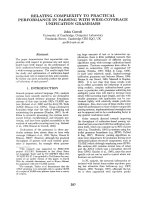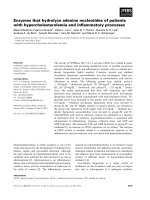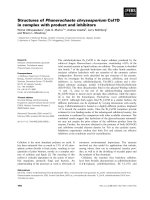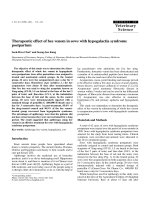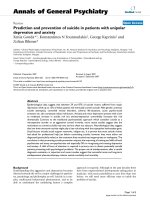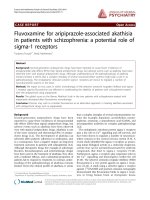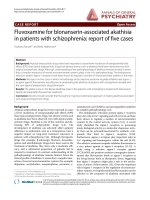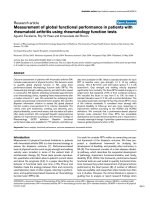Báo cáo khoa học: "Hydrocortisone infusion may improve survival in patients with severe community-acquired pneumonia" pps
Bạn đang xem bản rút gọn của tài liệu. Xem và tải ngay bản đầy đủ của tài liệu tại đây (65.36 KB, 2 trang )
Available online at
Evidence-Based Medicine Journal Club
EBM Journal Club Section Editor: Eric B. Milbrandt, MD, MPH
Journal club critique
Hydrocortisone infusion may improve survival in patients with severe
community-acquired pneumonia
Murugan Raghavan
1
and John A. Kellum
2
1
Clinical Fellow, Department of Critical Care Medicine, University of Pittsburgh School of Medicine, Pittsburgh, Pennsylvania, USA
2
Associate Professor, Department of Critical Care Medicine, University of Pittsburgh School of Medicine, Pittsburgh, Pennsylvania, USA
Published online: 20 October 2005
This article is online at
© 2005 BioMed Central Ltd
Critical Care 9: E24 (DOI 10/1186/cc3896)
Expanded Abstract
Citation
Confalonieri M, Urbino R, Potena A, Piattella M, Parigi P,
Puccio G, Della PR, Giorgio C, Blasi F, Umberger R, Meduri
GU: Hydrocortisone infusion for severe community-acquired
pneumonia: a preliminary randomized study. Am J Respir
Crit Care Med 2005, 171:242-248 [1].
Hypothesis
Hydrocortisone infusion in severe community-acquired
pneumonia (CAP) attenuates systemic inflammation and
leads to earlier resolution of pneumonia and a reduction in
sepsis-related complications.
Methods
Design: Prospective, randomized, double-blind, placebo-
controlled multi-center clinical trial.
Setting: Intensive care units and respiratory intermediate
units of six hospitals in Italy between July 2000 and March
2003.
Subjects: Forty-six patients admitted to the intensive care
unit with clinical and radiographic evidence of pneumonia
and either two minor or one major 1993 American Thoracic
Society criterion for severe pneumonia. Patients with
nosocomial pneumonia, immunosuppression, acute burn
injury, pregnancy, life expectancy less than 3 months, and
conditions requiring more than 0.5 mg/kg/day of prednisone
equivalent (such as acute asthma and COPD) were
excluded.
Intervention: Subjects were randomly assigned to receive
hydrocortisone infusion or placebo in addition to protocol
guided antimicrobial therapy. Hydrocortisone was given as
an intravenous 200mg bolus followed by infusion at a rate of
10 mg/hour for 7 days.
Outcomes: The primary end-points of the study were
improvement in PaO
2
:FiO
2
(PaO
2
:FiO
2
>300 or ≥100
increase from study entry) and multiple organ dysfunction
syndrome (MODS) score by Study Day 8, and development
of delayed septic shock. The secondary end-points were
duration of mechanical ventilation, length of ICU and
hospital stay, and survival to hospital discharge and to 60
days.
Results
The hydrocortisone group had lower PaO
2
:FiO
2
, higher
chest radiograph score and C-reactive protein (CRP) level
at study entry. However by study day 8, treated patients
had, compared with control subjects, a significant
improvement in PaO
2
:FiO
2
(p=0.002) and chest radiograph
score (p<0.0001), and a significant reduction in CRP levels
(p=0.01), MODS score (p=0.003), and delayed septic shock
(p=0.001). Hydrocortisone treatment was associated with a
significant reduction in length of hospital stay (p=0.03) and
mortality (p=0.009). There were seven deaths in the control
group, whereas none in the hydrocortisone group.
Conclusion
A seven-day course of low-dose hydrocortisone infusion in
patients with severe community-acquired pneumonia was
associated with a significant reduction in duration of
mechanical ventilation, hospital length of stay, and hospital
mortality.
Commentary
The role of glucocorticoids in patients with severe CAP is
uncertain. In patients with septic shock, however, several
recent randomized controlled trials have shown that low
doses of glucocorticoids administered for a prolonged
period of time shorten the duration of shock and improve
survival [2-4]. Although some of the patients in these studies
Critical Care December 2005 Vol 9 No 6 Raghavan and Kellum
had CAP as a source of sepsis, patients with CAP were not
analyzed separately. The study by Confalonieri and
colleagues is the first randomized study to evaluate the
efficacy and safety of low-dose hydrocortisone infusion
specifically in patients with severe CAP. The investigators in
this trial also attempted to explore the role of corticosteroids
in attenuating inflammatory response as assessed by serum
CRP levels. Previous studies assessing the role of
glucocorticoids in patients with CAP found no benefit in
terms of inflammatory mediator release but these studies
either used shorter courses of glucocorticoids or were not
powered to detect treatment differences [5-7].
The authors in the current study used a sequential trial
design with interim analyses approximately every 20
patients in order to reduce the number of patients exposed
to “inferior” treatment through early study termination if
treatment-related outcome differences emerged. In fact, the
study was stopped early, after only 46 subjects were
enrolled, when improvements in PaO
2
:FiO
2
and hospital
mortality were observed with hydrocortisone. There is little
doubt that clinical trials should be stopped early when there
is evidence of harm, but decisions to stop early for benefit
must be made cautiously, especially when surrogate
endpoints, such as improvement in PaO
2
:FiO
2
, are primary
outcome variables. Though the mortality difference was
highly significant (absolute risk reduction of 30% for hospital
mortality, p=0.009, NNT=3.3), only one or two deaths in the
hydrocortisone group would have been sufficient to tip the
balance toward a non-significant mortality difference and in
favor of study continuation, rather than early termination of
the trial.
This consideration notwithstanding, some important
limitations of this study deserve consideration. Because the
sample size was small, randomization did not achieve a
balance of prognostic factors between groups. Baseline
PaO
2
:FiO
2
values, CRP levels, and chest radiograph scores
were significantly worse in the hydrocortisone group and
there was a trend towards more comorbid illness, greater
age, and increased initial use of mechanical ventilation in
the placebo arm. Although the differences that reached
statistical significance would seem to bias against the
treatment, these differences do raise concerns that the
groups were not similar at the start of the trial. With the
current knowledge of the possible beneficial effects of
corticosteroids in patients with severe sepsis and adrenal
insufficiency [2], one also might question whether the
distribution of adrenal insufficiency was different between
the placebo and hydrocortisone groups. Unfortunately, no
data are provided regarding the adrenal function of these
patients. In a study of glucocorticoids, it is almost impossible
to keep the investigators completely blinded as white blood
cell counts and plasma glucose levels are likely to be
elevated in the glucocorticoid group, thereby introducing the
potential biases associated with inadequate blinding of the
investigators. As acknowledged by the authors, it is difficult
in a small study to control for center-specific effects,
especially when early study termination precludes any
meaningful subgroup analyses. Of particular concern is that
individual centers had very different outcomes (center
specific mortality ranged from 0% to 36%) and that
treatment allocation was not balanced at each site. A
smaller randomization block size would have solved this
latter issue, but only a larger study could have addressed
center-specific effects.
Recommendation
This study suggests that hydrocortisone may improve
survival in patients with severe CAP. However, as for any
drug therapy, most experts argue for a second study to
confirm the results. Given the small sample size and very
low mortality rate in the treatment arm, a larger multi-center
randomized controlled trial with 90-day mortality [8,9] as the
primary end point is needed before hydrocortisone can be
recommended as routine therapy for severe CAP.
Competing interests
The authors declare that they have no competing interests.
References
1. Confalonieri M, Urbino R, Potena A, Piattella M, Parigi
P, Puccio G, Della PR, Giorgio C, Blasi F, Umberger R,
Meduri GU: Hydrocortisone infusion for severe
community-acquired pneumonia: a preliminary
randomized study. Am J Respir Crit Care Med 2005,
171:242-248.
2. Annane D, Sebille V, Charpentier C, Bollaert PE,
Francois B, Korach JM, Capellier G, Cohen Y, Azoulay
E, Troche G, Chaumet-Riffaut P, Bellissant E: Effect of
treatment with low doses of hydrocortisone and
fludrocortisone on mortality in patients with septic
shock. JAMA 2002, 288:862-871.
3. Bollaert PE, Charpentier C, Levy B, Debouverie M,
Audibert G, Larcan A: Reversal of late septic shock
with supraphysiologic doses of hydrocortisone. Crit
Care Med 1998, 26:645-650.
4. Briegel J, Forst H, Haller M, Schelling G, Kilger E,
Kuprat G, Hemmer B, Hummel T, Lenhart A, Heyduck
M, Stoll C, Peter K: Stress doses of hydrocortisone
reverse hyperdynamic septic shock: a prospective,
randomized, double-blind, single-center study. Crit
Care Med 1999, 27:723-732.
5. Marik P, Kraus P, Sribante J, Havlik I, Lipman J,
Johnson DW: Hydrocortisone and tumor necrosis
factor in severe community-acquired pneumonia. A
randomized controlled study. Chest 1993, 104:389-
392.
6. Monton C, Ewig S, Torres A, El Ebiary M, Filella X,
Rano A, Xaubet A: Role of glucocorticoids on
inflammatory response in nonimmunosuppressed
patients with pneumonia: a pilot study. Eur Respir J
1999, 14:218-220.
7. Wagner HN, Jr., Bennett IL, Jr., Lasagna L, Cluff LE,
Rosenthal MB, Mirick GS: The effect of
hydrocortisone upon the course of pneumococcal
pneumonia treated with penicillin. Bull Johns Hopkins
Hosp 1956, 98:197-215.
8. Cohen J, Guyatt G, Bernard GR, Calandra T, Cook D,
Elbourne D, Marshall J, Nunn A, Opal S: New
strategies for clinical trials in patients with sepsis
and septic shock. Crit Care Med 2001, 29:880-886.
9. Angus DC, Carlet J: Surviving intensive care: a report
from the 2002 Brussels Roundtable. Intensive Care
Med 2003, 29:368-377.

